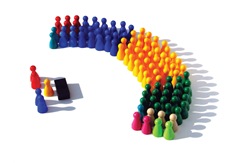Downsizing the Dáil?
 The pros and cons of reducing the number of TDs.
The pros and cons of reducing the number of TDs.
As the state’s population has increased, so too has the size of the Dáil. The current number – 166 TDs – has been in place since 1981 but some parties are now calling for a cut, amid the backdrop of wider job cuts and economic difficulties outside the chamber.
According to the Constitution, TDs must represent constituencies – a European-style list system was ruled out – and a TD should represent not more than 30,000 and not less than 20,000 constituents. A revision of constituencies must take place at least once every 12 years with the changes taking effect at the next Dáil election at the earliest.
Proportional representation must be used in elections with each constituency having a minimum of three TDs; the more populous ones have four or five representatives and no upper limit is set. There are 43 constituencies in total.
The pioneer of reducing the number of TDs appears to be the Green Party who, in opposition, called for a cut of the 130, using 1:30,000 ratio. Its ‘Democratic Communities’ policy calls for 100 of these seats to be filled using the current PR system and the other 30 seats using national party lists.
This would ensure parties with at least 2 per cent of the national vote would be represented. These TDs would be free to focus on national issues. However, none of these 30 ‘list’ TDs would be directly elected.
In a speech to the MacGill Summer School last July, Enda Kenny acknowledged that the public wanted fewer TDs and less pay for them. The current salary is €100,191.
“They are rightly outraged at politicians asking for sacrifices, while exempting themselves from major cuts. It is for this reason that I favour a reduction in the number of TDs. Depending on the results of the next census in 2011 the number of TDs could be reduced, without requiring a constitutional amendment,” he stated.
Kenny added that this move would not, by itself, “do anything” for political reform and other changes were needed, especially the decentralisation of power away from central government.
Based on current population figures, and the constitutional rules, he expects that the Dáil can be cut from 166 to 142 TDs, down by 24. He would wait to see what the 2011 census says before making any decision and expects a possible reduction of between 10 and 20.
The last census was held in 2006 and the last constituency review took place a year later. It recommended keeping the 166 number and some small increases or decreases in seats within that figure. At that point, the national average number of constituents per TD was 25,541 and there were no major variations from that statistical point. The next Dáil election, when these changes will take effect, must take place no later than 14 July 2012.
Any change to the constitution i.e. to vary the ratio or to introduce a list system, will require a referendum, and a future government would probably want to avoid campaigning on such a dry topic for voters.
Fine Gael supported setting up an electoral commission – similar to the one already existing in Britain and the North – which will be responsible for all aspects of elections.
However, the Programme for Government for 2007-2012 already allows for this and reviewing constituency boundaries would be within its remit. As TD Sean Ardagh writes on pages 32 and 33 of this edition, the Constitution Committee is also currently reviewing how TDs are elected.
While Kenny found people were cynical about politicians, they did want them to be there when they needed help. Reducing the number of TDs would make them represent a larger number of people and therefore may make them more distant.
Whatever number is chosen, one seat would still be held by An Ceann Comhairle who is automatically returned without an election, unless he or she retires from the Dáil. This protects the neutrality of the chair – as the chairman would otherwise have to campaign for re-election – but conversely means that voters cannot remove that TD from office if they wish.
As the idea of too many politicians is unpopular, too few would also be disliked so a balance will probably have to be found between those two poles of public opinion.





